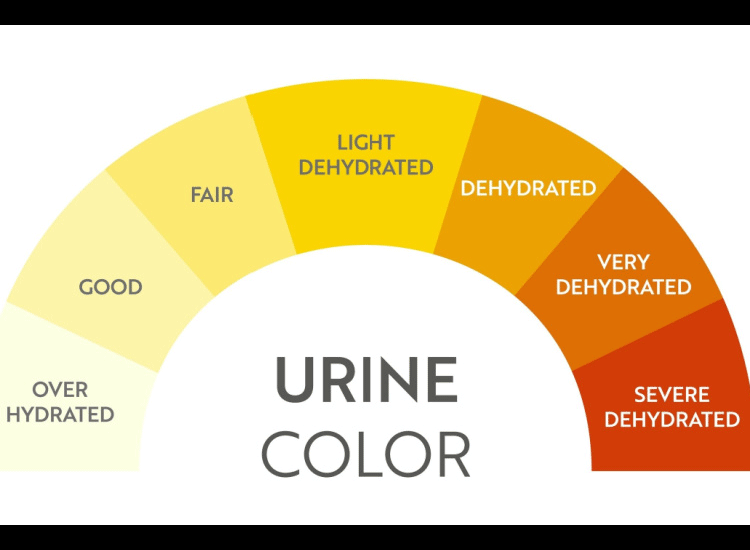Recognize These Abnormal and Healthy Urine Colors – Urine is the waste fluid produced by the kidneys and expelled through the urinary tract. Its color can vary, ranging from pale yellow to dark yellow, depending on influencing factors. Therefore, what do healthy and unhealthy urine colors look like? Find out by reading the following article.
Various Normal and Abnormal Urine Colors
Urine consists of various substances, ranging from water, electrolytes, to waste filtered by the kidneys. Additionally, the color of urine comes from an individual’s diverse intakes. Here is an explanation of the various urine colors, including:
1. Pale or Dark Yellow
Pale or dark yellow indicates a healthy and normal urine color, signaling that the body is well-hydrated. Generally, urine is yellow due to the presence of urochrome/urobilin, a pigment produced from the breakdown of red blood cells by the liver and excreted through urine. Additionally, the yellow color of urine can be caused by high levels of vitamin B in the body.
2. Transparent
Clear or transparent urine is also a characteristic of healthy urine color. This color indicates that the body is receiving more fluid intake than the recommended daily fluid needs. This is considered ideal as the body is well-hydrated.
However, you should not consume water in excess to achieve clear or transparent urine color. Excessively clear urine can lower the levels of salts and electrolytes needed by the body. It is advisable to drink around two liters of water per day instead.
3. Orange
Orange is generally not considered a healthy urine color. In fact, an orange urine color indicates dehydration, making it classified as an abnormal urine color. Regardless, orange urine can also be influenced by the consumption of certain foods or medications, such as laxatives and anti-inflammatories. This condition can also indicate a disturbance in the liver or bile ducts, especially if accompanied by light-colored feces.
4. Dark Yellow
In some cases, dark yellow or concentrated urine indicates mild dehydration. If this condition happens, it is advisable to increase fluid intake promptly to gradually restore normal urine color.
5. Blue or Green
Although urine typically has a yellowish color, it can also appear blue or green due to the influence of food coloring or medications, such as vitamin B supplements, promethazine, or cimetidine. However, this condition can also be caused by several medical conditions, such as:
Urinary tract infections caused by Pseudomonas bacteria.
Mild hypercalcemia.
Rare congenital anomalies, such as Blue Diaper Syndrome.
5. Reddish
Reddish urine, particularly when accompanied by pain and blood, should be a cause for concern as it can be a symptom of urinary disorders, such as prostate enlargement, kidney stones, and tumors in the bladder or kidneys.
However, there is nothing to be worried about when the red color is caused by consuming red foods, such as dragon fruit, beets, and berries, as these fruits can make urine turn reddish. Additionally, certain medications, including antibiotics for tuberculosis or laxatives, can affect the reddish color of urine.
6. Brown
Urine that has turned brown indicates severe dehydration. Furthermore, brown color can also be caused by medications or foods, such as fava beans and aloe vera.
Nevertheless, brown urine also needs to be monitored as it can be a sign of the following medical conditions:
Urinary tract infections.
Liver and kidney disorders.
Accumulation of chemicals inducing rusty-colored urine (porphyria).
7. Cloudy
Cloudy urine often indicates health issues, such as urinary tract infections, kidney disorders, symptoms of chronic diseases, or dehydration symptoms. In pregnant women, cloudy urine should be promptly consulted with a doctor as it can indicate pregnancy-related disorders, such as preeclampsia.
Other Characteristics of Healthy Urine
Besides color, there are several other characteristics of healthy urine:
Urine odor: Urine has a distinct odor derived from ammonia and waste expelled by the kidneys. However, healthy urine typically has a very faint odor, sometimes even odorless. In fact, healthy urine has a higher water content than waste. On the other hand, abnormal urine tends to have a strong odor due to high waste content.
Urination frequency: Generally, healthy individuals urinate about 6–8 times a day, although a frequency of 4–10 times is still considered normal as long as it does not disrupt daily activities. It is important to note that urination frequency can be influenced by age, fluid intake, types of beverages consumed, bladder size, pregnancy, and certain medications.
Urine volume: Typically, the amount of urine excreted by the body in a day is around 600–2000mL (depending on daily fluid intake). Each person may have a different urine volume, depending on their condition.
If you notice any unusual changes in urine color, it may be a sign of a specific medical condition. To confirm, immediately consult with a Urologist at the nearest Siloam Hospitals for accurate diagnosis and appropriate treatment.
Rekomendasi Link Alternatif :
- Prediksi Togel hk
- Casino online
- Casino online
- Okewla
- Okewla
- Okewla
- Bo togel
- Okewla
- Okewl
- Bo togel
- Togel casino
- Togel casino
- Scatter Pink
- Togel casino
- Okewla
- Okewla
- Okewla
- Okewla
- Agen togel
- Bo togel
- Togel casino
- Bo togel
- Agen togel
- Scatter hitam
- Angka main hk
- Slot thailand
- Slot dana
- Agen togel
- Togel terbesar


No Responses